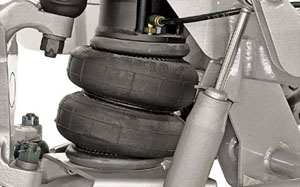| Main factors affecting the replacement cycle | Common signs that the shock absorber needs to be replaced | |
| 1. Usage environment and road conditions Poor road conditions: Driving on potholed and bumpy roads (such as rural dirt roads and construction sections) for a long time will significantly accelerate the wear and tear of the shock absorbers, and the replacement cycle may be shortened to 30,000 - 50,000 kilometers. Urban road conditions: For urban driving mainly on flat roads, the shock absorber has a relatively long lifespan. It can usually be used for 50,000 - 80,000 kilometers, or even longer. 2.Driving habits Aggressive driving: Frequent rapid acceleration, sudden braking, or driving over potholes at high speed will intensify the wear and tear of components such as the internal pistons and oil seals of the shock absorber, shortening its lifespan. Smooth driving: A gentle driving habit can extend the service life of the shock absorber. 3.Shock absorber type Ordinary hydraulic shock absorbers: Low cost, average durability. The regular replacement cycle is 50,000 - 80,000 kilometers. Inflatable shock absorbers (such as nitrogen shock absorbers): Have better performance and strong anti-decay ability. If properly maintained, they can be used for 80,000 - 100,000 kilometers. Adjustable shock absorbers (such as air suspension): Need to be maintained in combination with the electronic system. If problems such as air leakage or damping adjustment failure occur, timely inspection, repair or replacement is required.  |
Even if the mileage has not been reached, if the following symptoms occur, immediate inspection or replacement is required: 1. Driving abnormal noise: When driving over bumpy roads, there is a "gurgling" sound or a metal impact sound. This may be due to loose internal parts of the shock absorber or insufficient oil. 2. Abnormal vehicle body shaking: If the vehicle body "nods" significantly when braking, or the steering wheel vibrates and the vehicle body is unstable at high speeds, it indicates that the shock absorber damping has failed. 3. Obvious oil leakage: If there is oil seeping out from the outside of the shock absorber cylinder body (the oil stain is black or brown), it indicates that the oil seal is damaged. After the internal oil leaks out, the shock absorption performance drops significantly. 4. Vehicle body skew: If the heights of the shock absorbers on both sides of the wheels are inconsistent, or the vehicle body automatically sinks after parking, it may be that the shock springs or shock absorbers are damaged. 5. Decline in handling: If the roll increases when cornering, the tire grip weakens, and the road feedback becomes "harder" or "softer", it may all be manifestations of the attenuation of the shock absorber performance. .jpg) |
| Factor | Ordinary hydraulic shock absorber | Inflatable / High-performance Shock Absorber |
| Regular mileage | 50,000 - 80,000 kilometers | 80,000 - 100,000 kilometers |
| Poor road conditions | 30,000 - 50,000 kilometers | 50,000 - 70,000 kilometers |
| Symptoms of a fault appear | Check and replace immediately | Check and replace immediately |